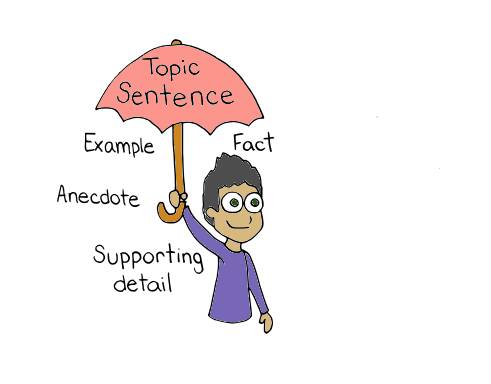72 Writing Paragraphs and Topic Sentences
A previous chapter (chapter 5) briefly introduced you to the fundamentals of writing in terms of paragraph and sentence construction. Here, you will learn more about developing paragraphs and topic sentences to support your ideas. Paragraphs are a group of sentences that form the main structural component of your paper. Each paragraph focuses on a single idea that relates to your main idea or thesis.
A topic sentence helps you introduce a paragraph. The job of the topic sentence is to control the development and flow of the information contained in the paragraph. It shapes the specific topic of the paragraph and how you present it to readers.
Placement of topic sentences
The topic sentence is often, but not always, the paragraph’s first sentence. Placing a topic sentence at or near the beginning of the paragraph is a good strategy. If you announce a topic clearly and early on in a paragraph, your readers are likely to grasp your idea and to make the connections that you want them to make.
One way to think about a topic sentence is that it presents the broadest view of what you want your readers to understand. You’re announcing or bringing into focus the purpose or meaning of the paragraph. If you think of the topic sentence as presenting the broadest view, then you can think of how every supporting detail within the paragraph brings a narrower, more specific view of the same topic. See Figure 7.3.

Figure 7.3: Topic sentence as an umbrella
Characteristics of good topic sentences
If an instructor or other reader comments that your paragraph lacks unity, you probably need a better topic sentence (or maybe you don’t have one yet). See Table 7.1 for examples of good and not-so-good topic sentences. A good topic sentence should meet the following criteria:
- Signals the topic and more focused ideas within the paragraph.
- Presents an idea or ideas that are clear and easy to understand.
- Provides unity to the paragraph (clarifies how all supporting ideas relate).
- Links to the purpose or thesis of your paper.
- Omits supporting details.
- Engages the reader.
Table 7.1: Examples of good and not-so-good topic sentences
| Topic | Not-so-good topic sentence | Good topic sentence |
|---|---|---|
|
Sugar leads to ill-health
|
Sugar is often used as a substitute for fat in many foods. *In this case, the sentence isn’t great because while it may speak to the pervasiveness of sugar, it doesn’t link the information back to how it serves as an agent of ill-health. |
High levels of sugar alter blood viscosity, rendering it thicker, which can lead to hypertension. *In this case, the sentence supports the main topic of sugar leading to ill-health, and hones in on one particular reason why sugar is not good for health. |
The paragraph body: Supporting your ideas
Whether you draft a paragraph based on a main idea, or whether the idea surfaces in the revision process, once you have the main idea you need to ensure that you support it. The job of the paragraph body is to develop and support the topic. Here’s one way to think about it:
- Topic sentence: What is the main claim of your paragraph? What is the most important idea that you want your readers to take away from this paragraph?
- Support in the form of evidence: How can you prove that your claim or idea is true (or important, or noteworthy, or relevant)?
- Support in the form of analysis or evaluation: What discussion can you provide that helps your readers see the connection between the evidence and your claim?
- Transition: How can you help your readers move from the current idea to the next idea?
Now that you have a good idea what it means to develop support for the main ideas of your paragraphs, let’s explore how to make sure that those supporting details are solid and convincing. Types of support might include: reasons, facts, statistics, quotations, and examples.
Attribution statement
Content from this page was remixed with our own original content and adapted from:
The Word on College Reading and Writing by Carol Burnell, Jaime Wood, Monique Babin, Susan Pesznecker, and Nicole Rosevear, licensed under a Creative Commons Attribution-NonCommercial 4.0 International License, except where otherwise noted.Download for free at: https://openoregon.pressbooks.pub/wrd/

